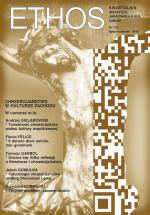 zobacz powiększenie | DOI 10.12887/29-2016-3-115-03 Anna BŁAŻEJEWSKA – ‘Native’ Art in the Polish Territory During the Period of Christianization: A Tentative Characterization Cena brutto: 7,00 PLN za szt. |
|
The article aims at a synthetic presentation of native, late tribal art in the period of the Christianization of Poland. Material manifestations of the culture in question are investigated by a number of disciplines, in particular archelogy, art history and history. However, a proper evaluation of the phenomenon discussed in the paper has not been accomplished in Polish art history yet. My presentation of late tribal art in the period of the Christianization of Poland considers mainly the phenomena which appear most interesting to the art historian: figural representations (monumental images as well as small format art), and cult buildings. Those objects had a particular significance to late heathen communities and they may be categorized according to the criteria used by art history (such as the style, the type, the convention or representation). My analysis of the preserved figural art monuments (and of those we know only from the descriptions provided by medieval chroniclers) points to the existence of a range of culturally varied areas within the Polish territory, namely: the middle area (including the Wielkopolska region), the southern part (the Silesia and the Małopolska), as well as the northern region (the Pomerania and the ethnically distinct Prussia). There is a scarce number of monuments preserved in Wielkopolska (among them large ones, such as the so-called ‘head from Jankowo,’ the two statues from Powiercie near Koło, and the ‘head from Dąbrówka’ found in the area bordering with the Małopolska, as well as manifestations of small format art, e.g. the ‘goatie’ from Lednogóra). All those objects exhibit the formal qualities characteristic of medieval sculpture. However, neither polycephal images (popular in the Slavonic territories) nor remains of cult buildings were found in that area. The southern part of the Polish territory in turn is characterized by the absence of monumental images (I believe the group of monuments from around Ślęża should be placed earlier than early middle ages). A number of bas-reliefs, specifically of zoomorphic character, were preserved there though. Neither in Great Moravia nor in the Czech territory (with the exception of Ploveč) were monumental statues erected. It might have been the close relations with those states that resulted in the absence of such statues also from southern Poland. Pagan monumental cult sculpture might have appeared only later, during the pagan revolt of the 1030’s, when a pagan temple was erected in Wrocław (Vratislavia). Most figural images and cult buildings were found in the northern region. They manifested an immense diversity and included, among others, the statue from Łubowo, the plate from Słupsk, and the stone from Leźno, as well as numerous instances of small (also polycephal) objects, and a distinct phenomenon: a big group of Prussian figures, inaccurately called ‘stone babas.’ Unlike in the Wielkopolska region, all those objects exhibit a high degree of schematization. They were created in the latest period and, together with the richly decorated wooden temples (we know from the descriptions provided by medieval chroniclers) where statues of pagan deities were worshipped, they combined the tradition of primeval ‘sign’ art characteristic of those territories with the effective cult ‘setting’ inspired by Christian art. Keywords: art, late tribal sculpture, early medieval Polish native art, pagan cult sculptures Contact: Katedra Historii Sztuki i Kultury, Wydział Nauk Historycznych, E-mail: abl@umk.pl Pliki do pobrania: » 115Blazejewska.pdf | |
